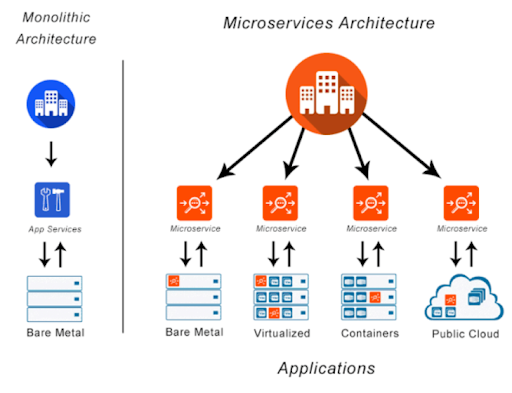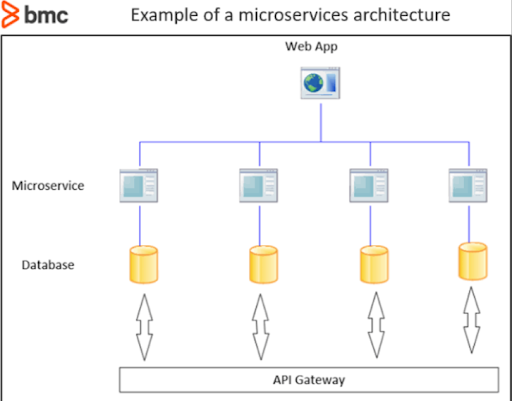Customers in the modern digital era are driving innovation by demanding ever-increasing returns from their tech investments. We have entered a software-driven era, made possible by the convergence of smartphones as well as the cloud, when software dictates every aspect of our lives, from ordering food as well as rides to paying for utility and satisfying our leisure needs.
Due to the difficulties of providing fast scaling as well as experimenting with traditional monolithic structures, software development and implementation have progressed to meet this user-driven requirement.
Contemporary methods, like containers & microservices, are quickly replacing older ones as the standard, particularly for online and mobile applications.
Table of contents
- What is a container?
- What are Microservices?
- A comparison between Containers and microservices
- Problems with microservices and containers
- Conclusion
Table of Contents
What is a container?
Containers make it easy to deploy applications uniformly across environments by packaging them with all of their dependencies in one package. All of the executables, libraries, plus configuration files that are required to launch the programme are considered dependencies.
Similar to how containers for shipping revolutionised worldwide freight transportation by standardising and speeding up the process, software containers address the issue of consistently running software when transferred to different computing environments. A container hides the variations in operating systems and supporting infrastructure, making it suitable for deployment on developer laptops, local test environments, or cloud-based production environments.
Containers are structurally similar to virtual machines, but they share a kernel with the host OS, making them lighter, faster, as well as more memory efficient at boot. By eliminating the need for the hypervisor and instead relying on a container execution, it is possible to host a lot more containers—each with a size of several MB—on a single server over virtual machines (each with a size of several GB).
Among prominent open-source and free container management systems, Google’s Kubernetes stands far and wide above the competition. The most well-known commercialised container management solution, however, is Docker. Windows has kept up with the competition thanks to Microsoft’s Hyper-V containers, even though Linux has consistently been the preferred operating system for container technology.
What are Microservices?
A microservice is a service-oriented application element according to Gartner’s definition:
- Closely monitored
- Thoroughly enclosed
- Not tightly bound
- Deployable autonomously
- Separately extensible
The Amazon Web Services (AWS) microservice architecture states that the following are the key components of an application: a clear interface, lightweight application programming interfaces (APIs), and the services that operate the application processes. Learn more in detail with Microservices Training.
According to microservices.io, some of the features of microservices are:
- Very testable and simple to maintain
- Not tightly bound
- Deployable autonomously
- Designed to maximise company potential; and
- Run by a tight-knit staff
Consider the following illustration of an e-commerce web-based application as an example. By using a microservices architecture, you may divide up the following tasks:
- Service for logging
- Managing stock
- Transportation service
An API gateway would allow each service to talk to each other’s databases. As a result of decoupling creation and administration of services, it is possible to scale or modify individual services to meet changing requirements without affecting the whole application.
Instead of creating brand-new apps from the ground up, the focus with microservices adoption has been on reworking current monolithic applications. The complexity of maintaining hundreds of administrations across multiple teams highlights the need for appropriate infrastructure to support them, despite the fact that microservices offer alternatives for agility as well as scalability.

This is why methods like DevOps and CI/CD are more appropriate for managing the services quickly and effectively throughout their lifecycle, from design to creation and distribution.
A comparison between Containers and microservices:
Let’s check a fascinating summary of the differences and similarities between these two terms in a post:
A container is an efficient tool for distributing and sharing resources. People in the DevOps field are enthusiastic about it. One software design pattern is the microservice. Designers are enthusiastic about it.
Basically, what this comes down to is:
- Software architecture is the focus of microservices.
- The main focus of containers is the packaging and distribution of software.
This means that we have the option of using a container to host a microservice. However, it is far more advantageous to execute on demand skills microservices inside containers in order to fully benefit from both.
Using a single virtual machine (VM) to deploy a whole application, regardless of when a microservice architecture is in place, increases the danger of just one point of failure. However, by distributing the application’s components over numerous containers, you can take use of both the resilience and agility that come with using containers. This allows you to scale and upgrade individual services without affecting the overall programme in a negative way.
Containers also bring flexibility by letting development use any language they like to build apps, as they can deploy applications to any environment. Containers are more efficient than virtual machines (VMs) since they use less resources.
The security benefits of isolation with a larger attack surface mitigate the effects of a hacker’s or other security breaches on one microservice or container, which is an additional perk.
Problems with microservices and containers
When it comes to large-scale distributed deployments, the administration overhead is the main issue with containers with microservices. As a result, specialised tools that can facilitate orchestration and guarantee consistent deployment are going to be required for the deployment, monitoring, and administration of containers & microservices in such systems.
Additional difficulties encompass:
- The difficulty of dealing with microservices recorded in several languages
- Implications for network resource utilisation costs caused by distant calls across many services
- Managing logs for dispersed services makes it difficult to investigate causes or audit systems without using log aggregators.
Conclusion
It is impossible to overstate the importance of contemporary programmes that offer flexibility and resilience in this era of cloud computing and smartphone apps. The company is willing to take advantage of value proposals that provide advantages like improved security as well as a shorter time to market.
At the moment, the go-to method for restructuring and expanding legacy apps so they are cloud native is to use containers and microservices.






